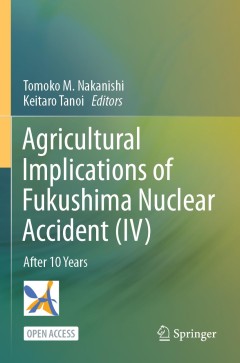Filter by

Green Recovery with Resilience and High Quality Development
- Edition
- 1
- ISBN/ISSN
- 978-981-19-9470-8
- Collation
- XXXIII, 625
- Series Title
- -
- Call Number
- -
- Edition
- 1
- ISBN/ISSN
- 978-981-19-9470-8
- Collation
- XXXIII, 625
- Series Title
- -
- Call Number
- -

Agricultural Implications of Fukushima Nuclear Accident (IV)
This open access book presents the findings from on-site research into radioactive cesium contamination in various agricultural systems affected by the Fukushima Daiichi Nuclear Power Plant accident in March 2011. This fourth volume in the series reports on studies undertaken at contaminated sites such as farmland and forests, focusing on soil, water, mountain, agricultural products, and animal…
- Edition
- 1
- ISBN/ISSN
- 978-981-19-9361-9
- Collation
- XIII, 276
- Series Title
- -
- Call Number
- -

Democratizing Risk Governance
This open access book features contributions from a multidisciplinary team of leading and emerging scholars focused on democratization of risk assessment, management, and communication. The volume identifies and sheds light on key risk governance dilemmas related to public trust, risk perception and public participation. The first part of the book articulates the relationship among science, exp…
- Edition
- -
- ISBN/ISSN
- 978-3-031-24271-7
- Collation
- XVIII, 421
- Series Title
- -
- Call Number
- -

Quantifying Climate Risk and Building Resilience in the UK
This open access book draws together key research from the UK Climate Resilience programme. It focuses on topics central to the programme’s research agenda, including improved characterisation and quantification of climate risks, enhanced understanding of the management of climate risks, and the development and delivery of climate services. Key chapters address the challenges inherent to unde…
- Edition
- -
- ISBN/ISSN
- 9783031397295
- Collation
- XXIV, 221
- Series Title
- -
- Call Number
- -

People or Property: Legal Contradictions, Climate Resettlement, and the View …
This open access book explores the intersection of property law, relocation, and resettlement processes in the United States and among communities that grapple with migration as an adaptation strategy. As communities face the prospect of relocating because of rising seas, policy makers, disaster specialists, and community leaders are scrambling to understand what adaptation pathways are legally…
- Edition
- -
- ISBN/ISSN
- 978-3-031-36872-1
- Collation
- XXI, 242
- Series Title
- -
- Call Number
- -

Vermin, Victims and Disease : British Debates over Bovine Tuberculosis and Ba…
This open access book provides the first critical history of the controversy over whether to cull wild badgers to control the spread of bovine tuberculosis (bTB) in British cattle. This question has plagued several professional generations of politicians, policymakers, experts and campaigners since the early 1970s. Questions of what is known, who knows, who cares, who to trust and what to do ab…
- Edition
- 1
- ISBN/ISSN
- 9783030191863
- Collation
- XXIV, 366 hlm,: ill, lamp; 21 cm
- Series Title
- -
- Call Number
- -

Smart Cities
This edited volume discusses the socioeconomic, environmental, and policy implications of smart cities. Written by international experts in energy economics and policy, the chapters present wide range of high quality theoretical and empirical studies at the nexus of social, entrepreneurial, governmental and ecological transformation. The book covers a wide range of topics, with a view towards p…
- Edition
- -
- ISBN/ISSN
- 978-3-031-35663-6
- Collation
- XV, 388
- Series Title
- -
- Call Number
- -

Die unsichtbaren Folgen des Extraktivismus : Ein Blick hinter die slow violen…
Dieses Open-Access-Buch beschäftigt sich mit Umweltproblemen, die selbst im Kontext der heutigen globalen ökologischen Krise weitgehend gesellschaftlich unsichtbar bleiben, da sie ihre oftmals schwerwiegenden sozial-ökologischen Auswirkungen allmählich, schleichend und über längere Zeiträume hinweg in Form einer slow violence (Rob Nixon) entfalten. Am Beispiel der toxischen Industrieabf�…
- Edition
- -
- ISBN/ISSN
- 978-3-658-43288-1
- Collation
- XIX, 568
- Series Title
- Energiepolitik und Klimaschutz. Energy Policy and Climate Protection (EPKS)
- Call Number
- -

GeomInt—Discontinuities in Geosystems From Lab to Field Scale
This is an open access book. In view of growing conflicts over strategic georesources, the use of the geological subsurface in the sense of a regional resource is becoming increasingly important. In this context, georeservoirs are playing an important role for the energy transition not only as a source of energy but also as a storage facility and deep geological disposal for energy waste. The s…
- Edition
- -
- ISBN/ISSN
- 978-3-031-26493-1
- Collation
- X, 98
- Series Title
- SpringerBriefs in Earth System Sciences (BRIEFSEARTHSYST)
- Call Number
- -

The Sanitation Triangle : Socio-Culture, Health and Materials
This open access book deals with global sanitation, where SDG 6.2 sets a target of enabling access to sanitation services for all, but has not yet been achieved in low- and middle-income countries. The transition from the United Nations MDGs to the SDGs requires more consideration based on the socio-cultural aspects of global sanitation. In other words, equitable sanitation for those in vulnera…
- Edition
- -
- ISBN/ISSN
- 978-981-16-7711-3
- Collation
- X, 264
- Series Title
- Global Environmental Studies (GENVST)
- Call Number
- -
 Computer Science, Information & General Works
Computer Science, Information & General Works  Philosophy & Psychology
Philosophy & Psychology  Religion
Religion  Social Sciences
Social Sciences  Language
Language  Pure Science
Pure Science  Applied Sciences
Applied Sciences  Art & Recreation
Art & Recreation  Literature
Literature  History & Geography
History & Geography